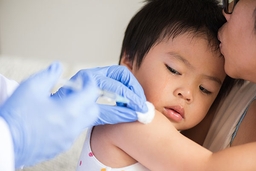Mandatory Vaccines for Children Aged 4–6

Which parent doesn't want their children to be healthy and safe from various diseases? Every single parent does. Providing a complete vaccination for their preschool child is the main step to making it happen.
Vaccinations are required for all children. The goal is to stimulate the body's immune system. Following vaccination, it is hoped that the child's body will be better able to deal with infections from various diseases, resulting in better health.
Vaccines have been administered to children since birth. However, some vaccines must be administered again when the child is 4–6 years old. What exactly are they?
1. DTP vaccine, 5th dose
The DTP vaccine protects children against diphtheria, tetanus, and pertussis (whooping cough). Diphtheria affects the upper respiratory system and the throat. This condition makes it difficult for patients to swallow and even breathe. Diphtheria can cause heart failure, paralysis, and even death in some cases.
Pertussis is a bacterial infection of the respiratory tract and lungs. A violent and uncontrollable cough that causes the sufferer to have difficulty breathing. This disease is extremely contagious and can even kill infants.
Tetanus is a disease that affects the nervous system. Muscle contractions will occur in a person infected with Clostridium tetani bacteria, particularly in the jaw and neck muscles. The DtaP vaccine is necessary to protect your child from this infection that comes from a skin cut or puncture wound.
The doctor will recommend that the child receive five doses of the DTaP vaccine, one dose at each of the following ages: 2 months, 3 months, 4 months, 18 months, and 4–6 years.
2. MR/MMR vaccine, 3nd dose
The MMR vaccine shields children from measles, mumps, and rubella (German measles). Measles is distinguished by a skin rash. The measles virus causes upper respiratory tract infection. Coughing up phlegm, a runny nose, a high fever, and red eyes are early signs of infection. Meanwhile, a red rash on the skin is the first sign of rubella.
Mumps is a virus-induced inflammation of the ducts of the salivary glands on the side of the face. Mumps is a contagious disease with no known cure.
To prevent these diseases, children receive three doses of the MMR vaccine. For MR, the age range is 9 months, while for MR/MMR, it is 15-18 months or 5-7 years.
3. Chickenpox (varicella) vaccine, 2nd dose
Chickenpox typically affects children under the age of 12. Adults who have not been infected with the varicella-zoster virus can, however, get chickenpox. An itchy rash and a fever are among the symptoms. After 1–2 days, redness appears, followed by water-filled blisters. The chickenpox virus is extremely contagious.
This disease can be avoided by administering chickenpox vaccinations at the ages of 12–23 months and 4–6 years.
4. Annual flu vaccination
The flu virus spreads easily. The nose, throat, and lungs are all infected by this virus. Coughing, fever, body aches, fatigue, vomiting, and diarrhea are all symptoms. The flu vaccine is administered once a year.
Children as young as six months are given the flu vaccine. Meanwhile, children under the age of nine who are getting their first flu vaccine need two doses at least 28 days apart.
Vaccination side effects

The majority of vaccination side effects are minor and short-lived. Here are the most common side effects:
- For 2–3 days, the injection site may appear red, swollen, and slightly painful.
- Infants and young children are usually fussy or have a high fever for 1–2 days.
- Some children may cry and be irritated immediately after the injection. This is normal. They will feel better after receiving a hug.
As a result, the government, through the Ministry of Health, has increased the number of mandatory vaccinations for children in the month of immunization 2022. Initially, 11 vaccines were developed into 14 vaccines. Pneumococcal conjugate vaccine (PCV), rotavirus vaccine, and human papillomavirus (HPV) vaccine are the vaccines. Depending on the type of vaccine used and the patient's age, the number of administrations can be done 2-3 times.
The PCV vaccine protects against Pneumococcus bacteria-caused diseases such as pneumonia, meningitis, and ear inflammation, whereas the rotavirus vaccine protects against rotavirus-caused severe diarrhea and its complications. Meanwhile, the HPV vaccine is used to protect women from cervical cancer. This vaccine is given to schoolchildren, particularly girls in grades 5 and 6.
The PCV vaccine has been available nationwide since 2022, and the new HPV virus has been distributed to 131 regions and cities across eight provinces. Four provinces in Java and four provinces outside of Java (DKI Jakarta, DI Yogyakarta, Central Java, East Java, North Sulawesi, Southeast Sulawesi, Gorontalo, and Bali).
Meanwhile, the rotavirus vaccine will be made available nationwide in 2024. The government pays for all mandatory routine immunization programs.
If you want to consult or give the right vaccine according to the age of your baby, click on WhatsApp.



